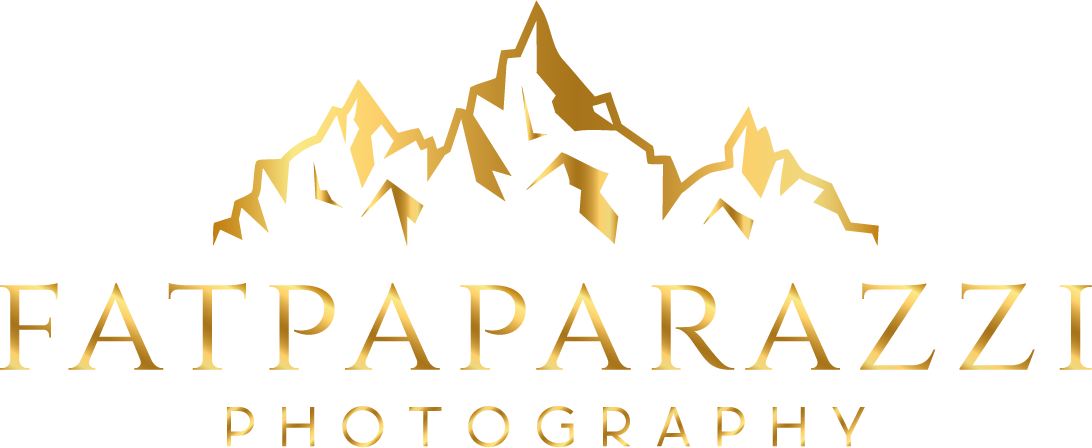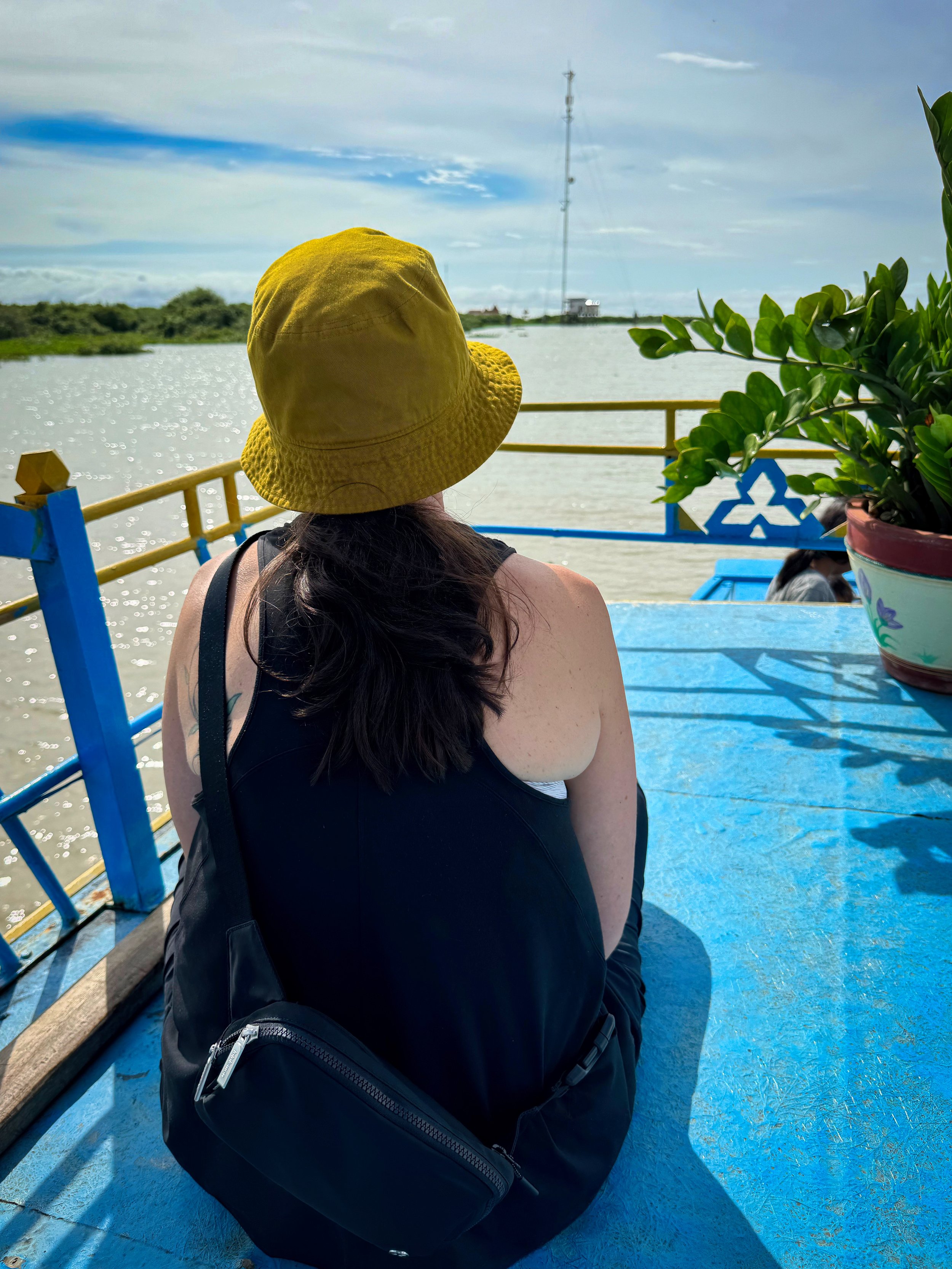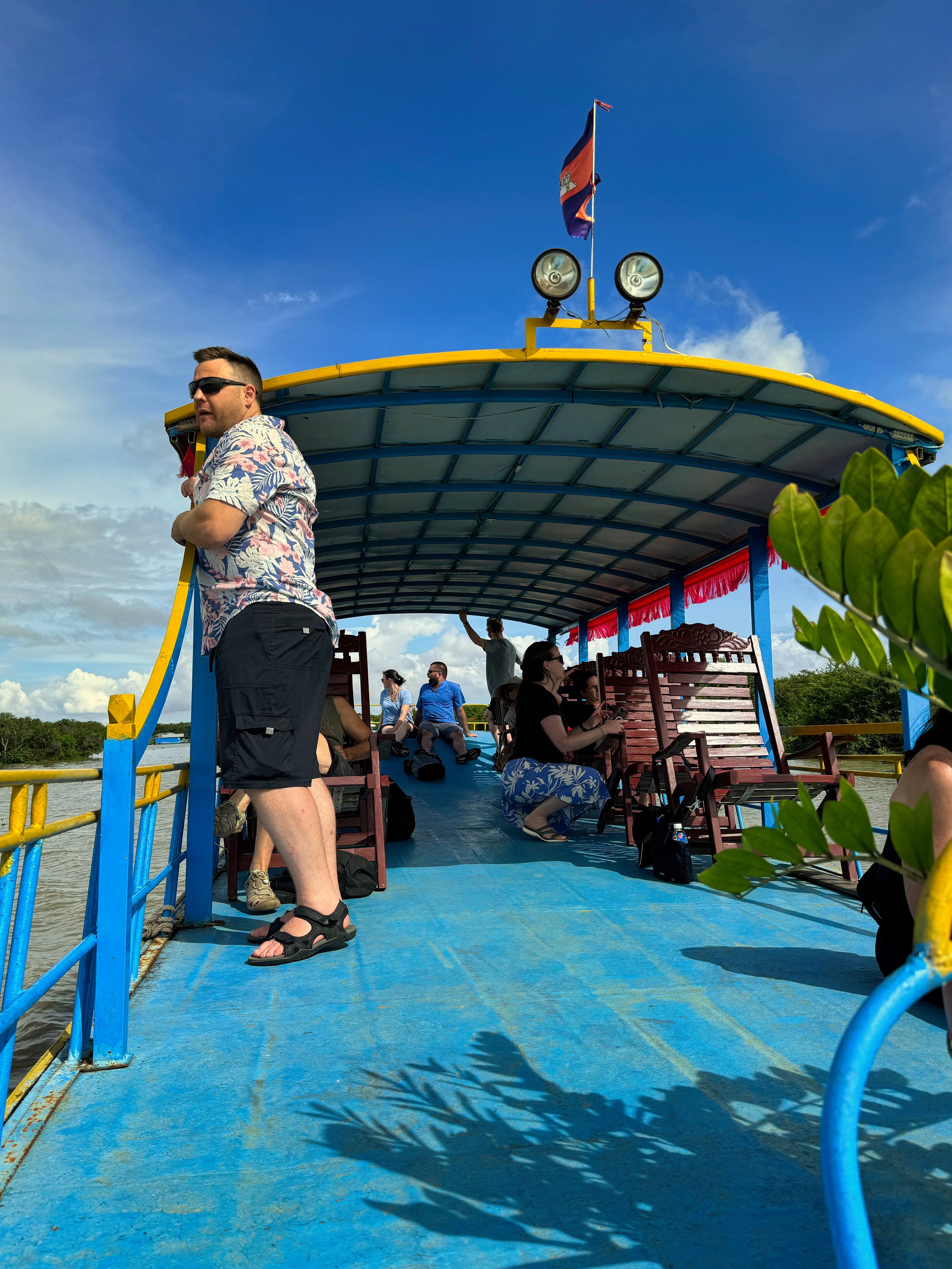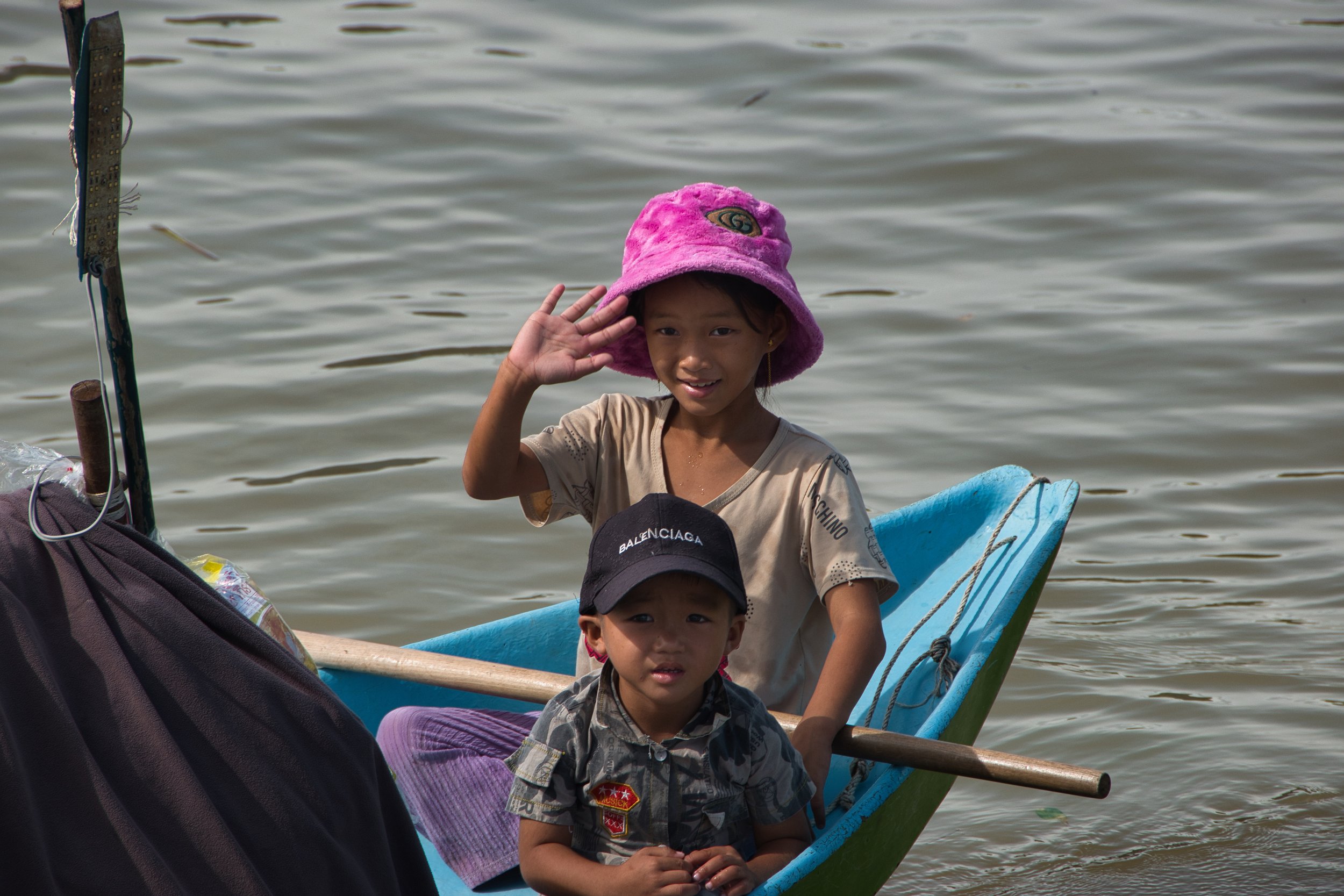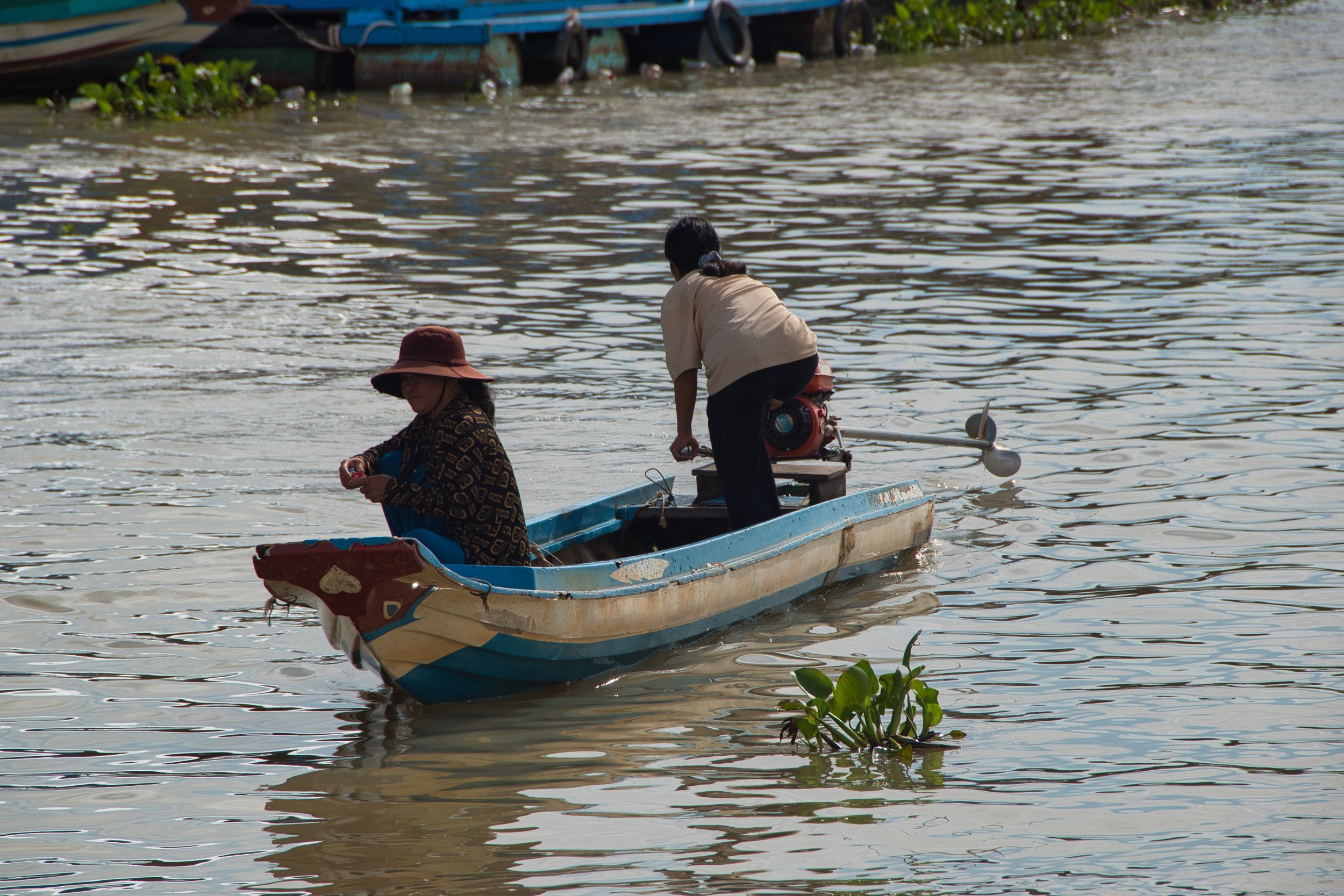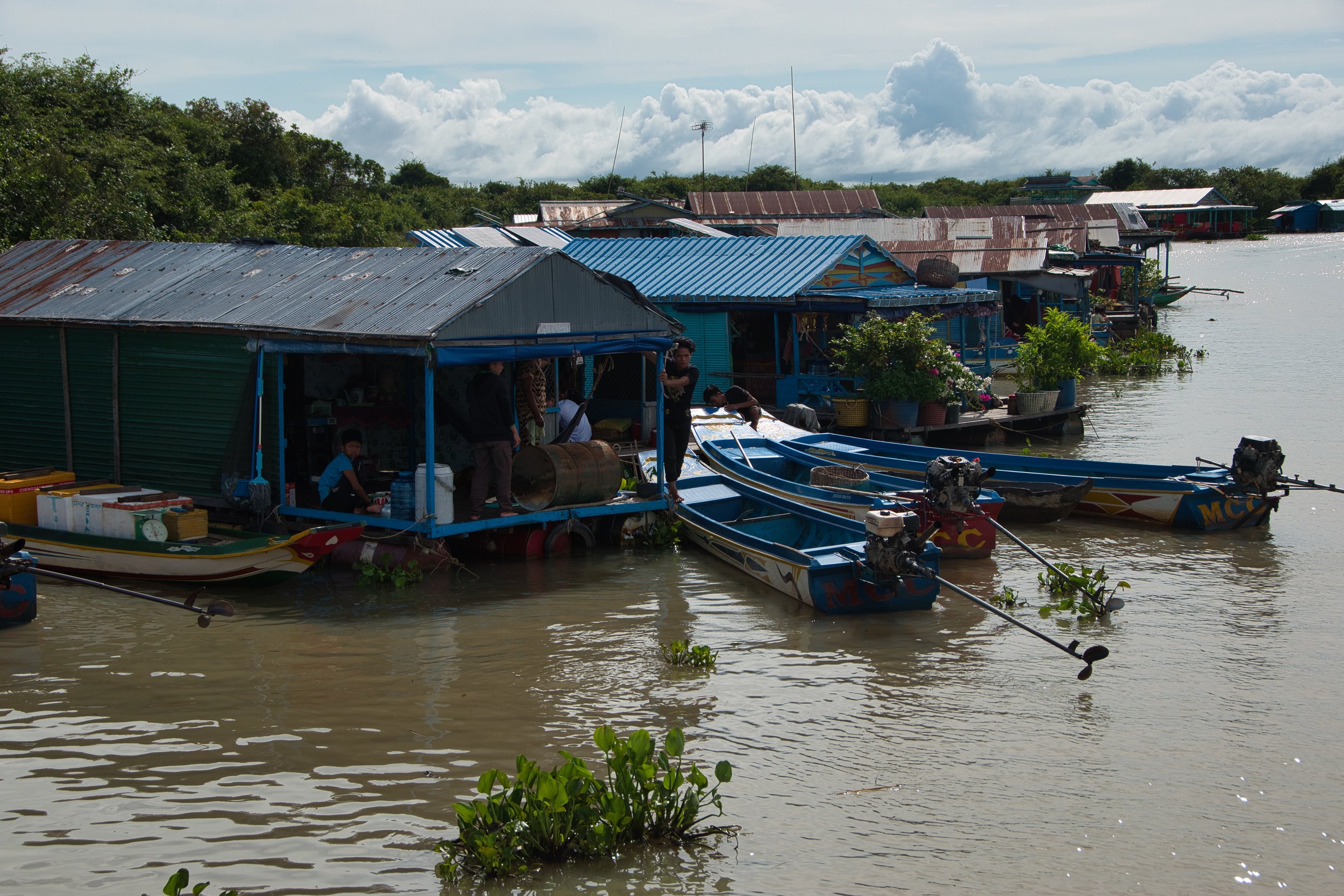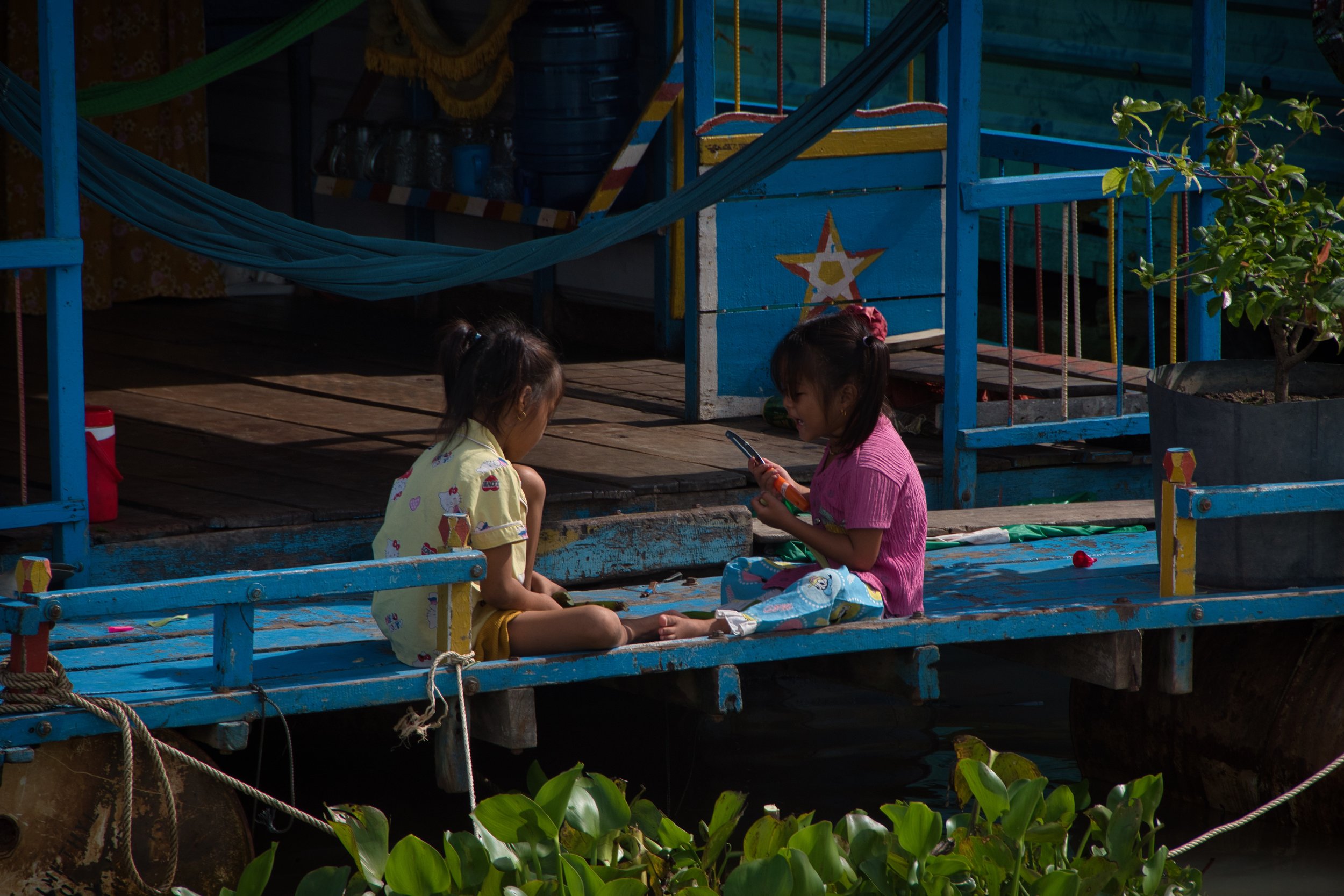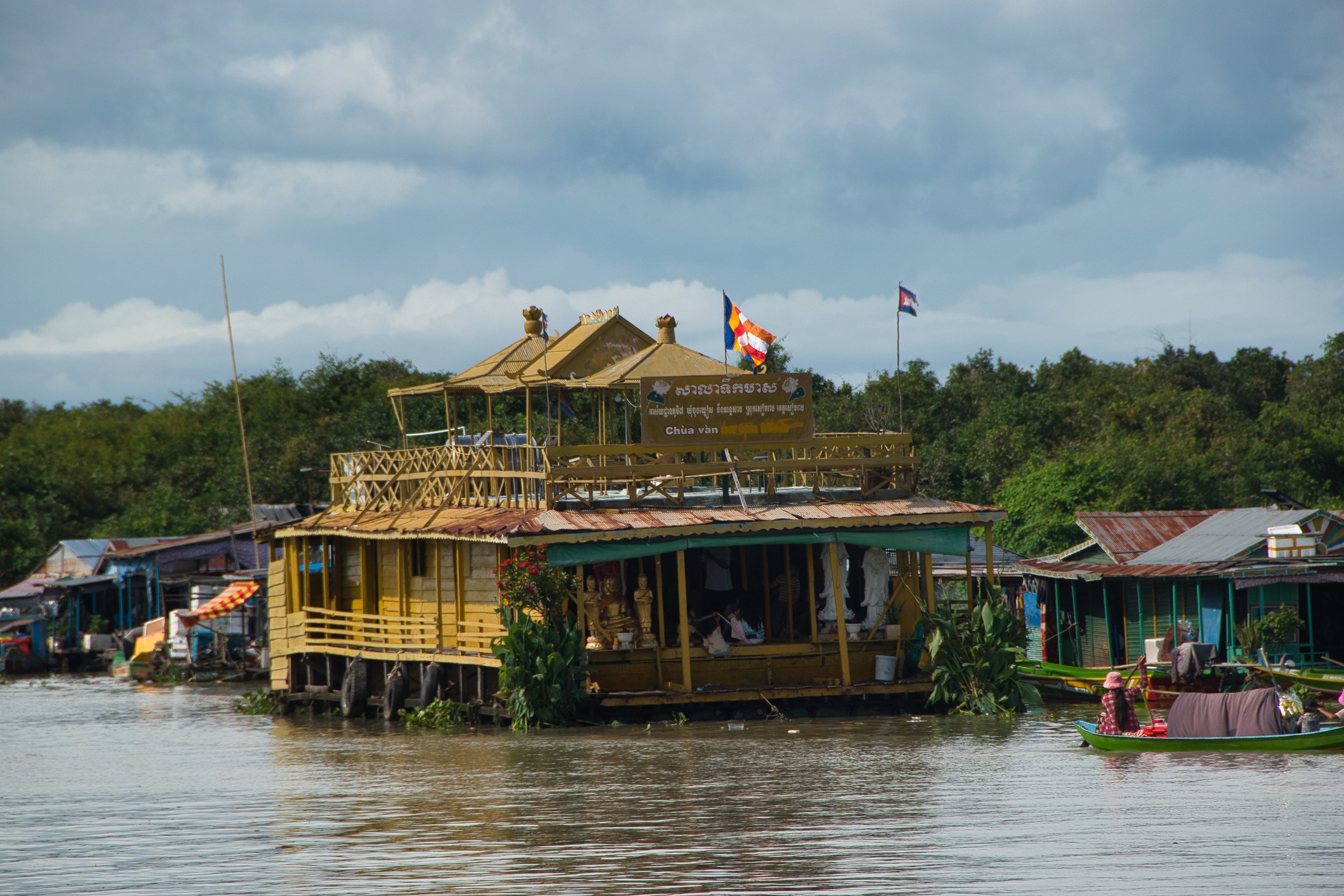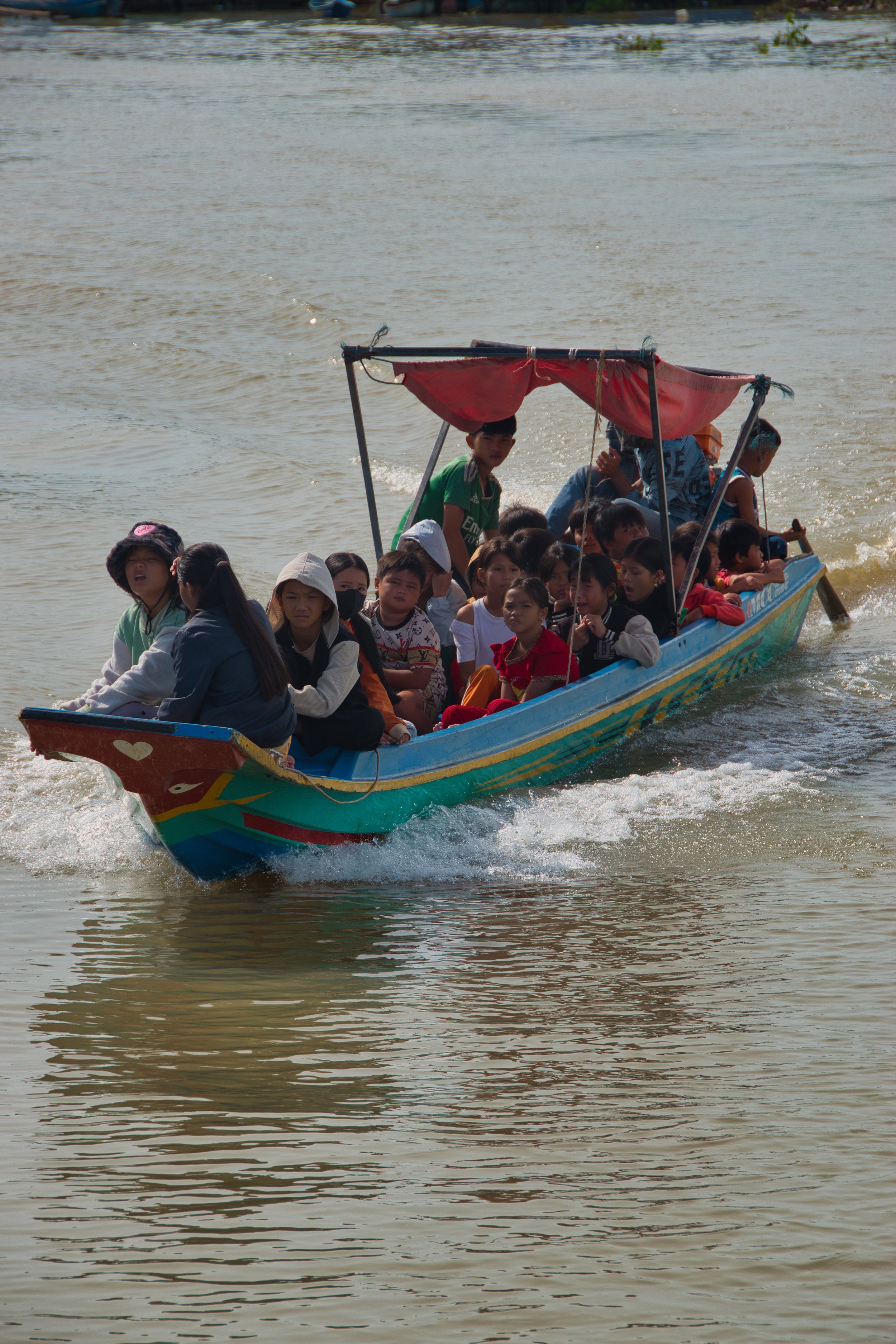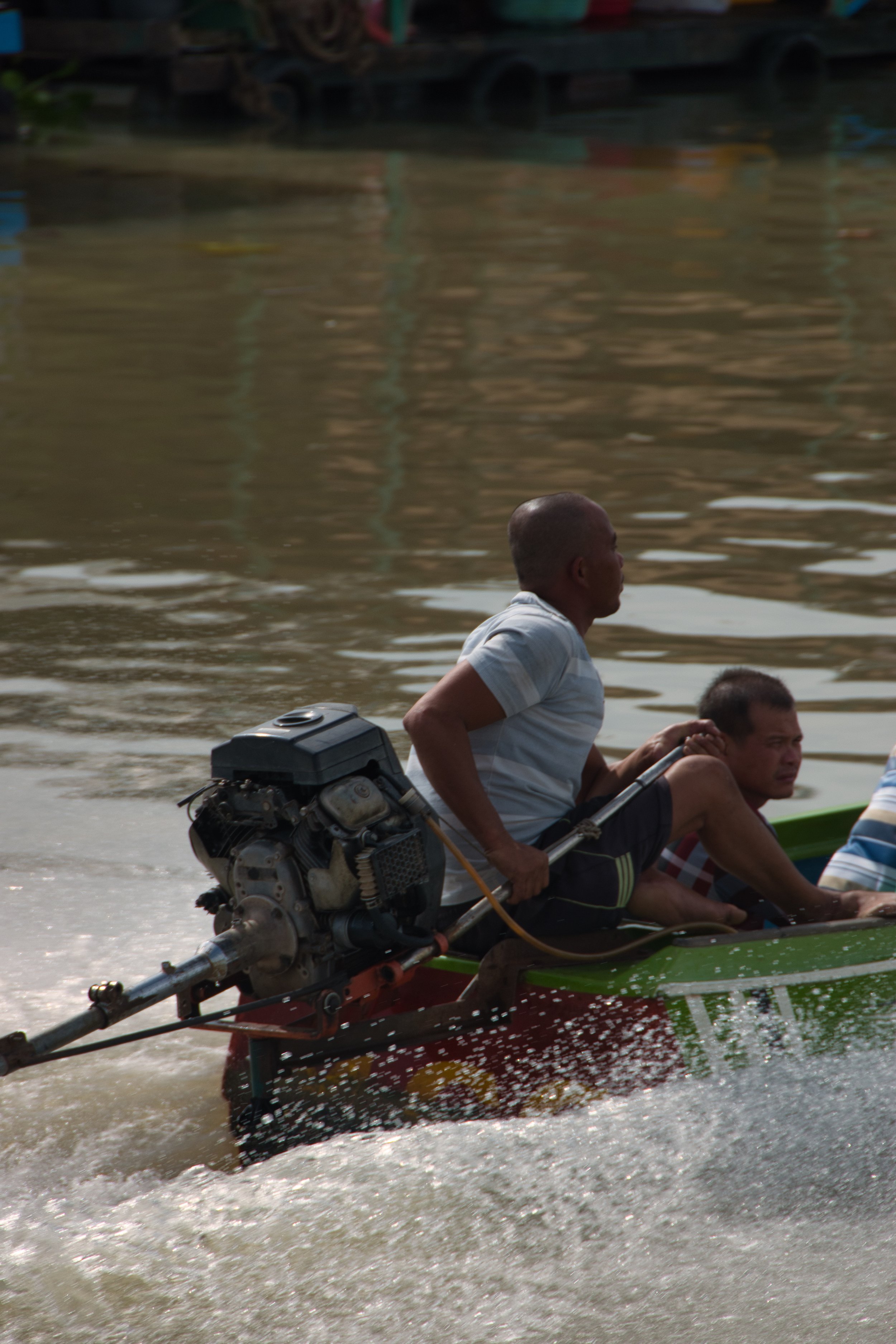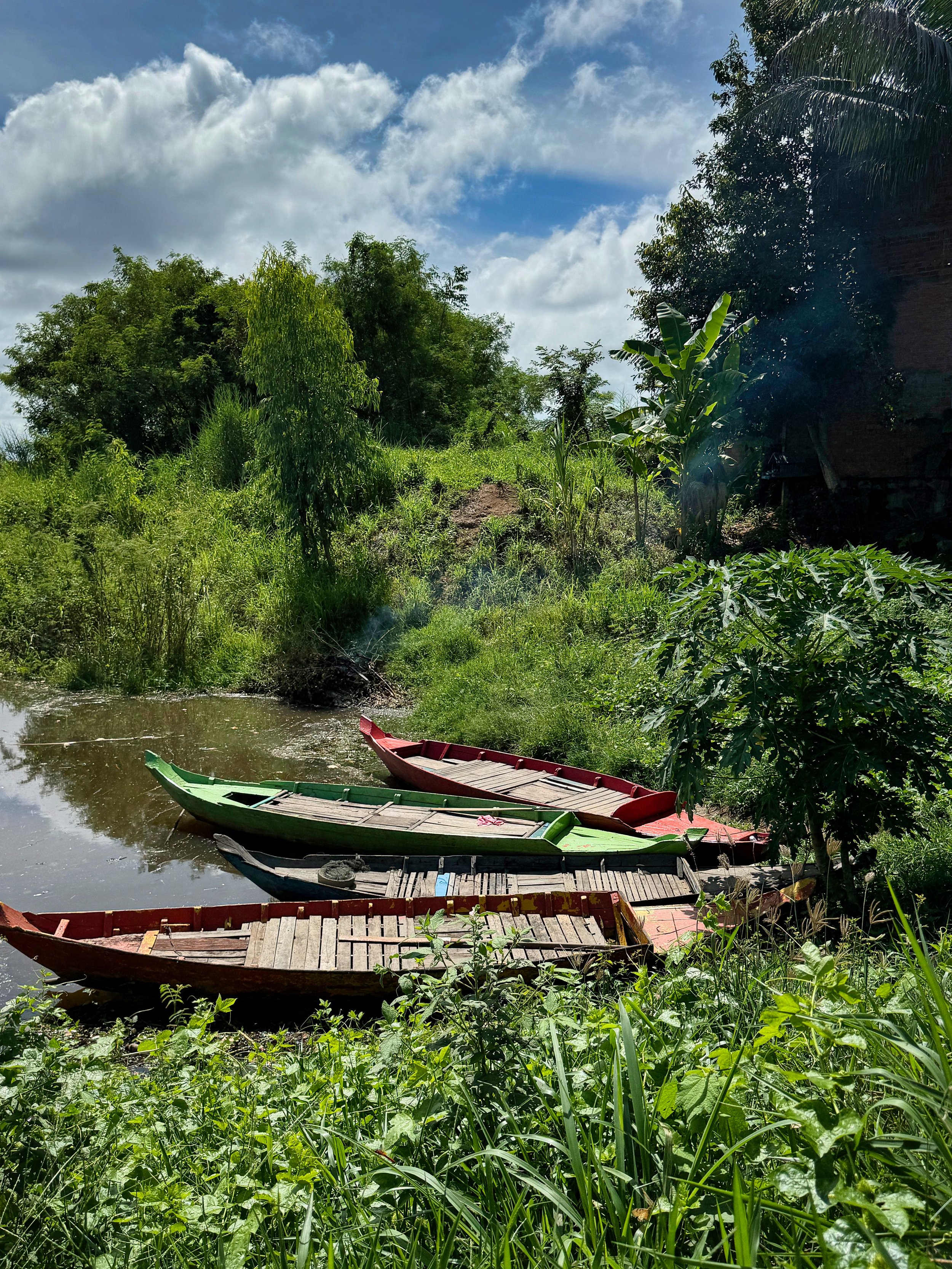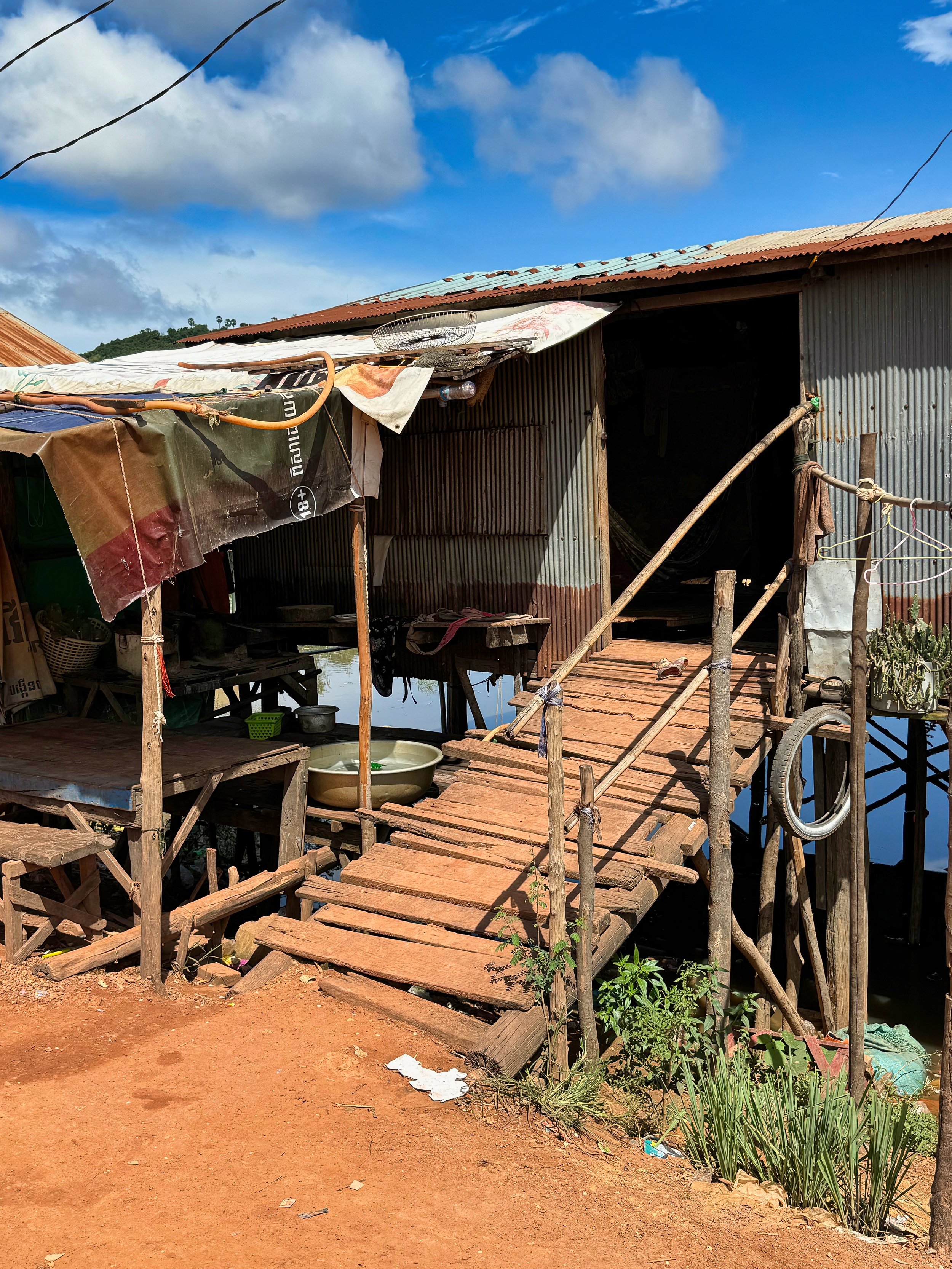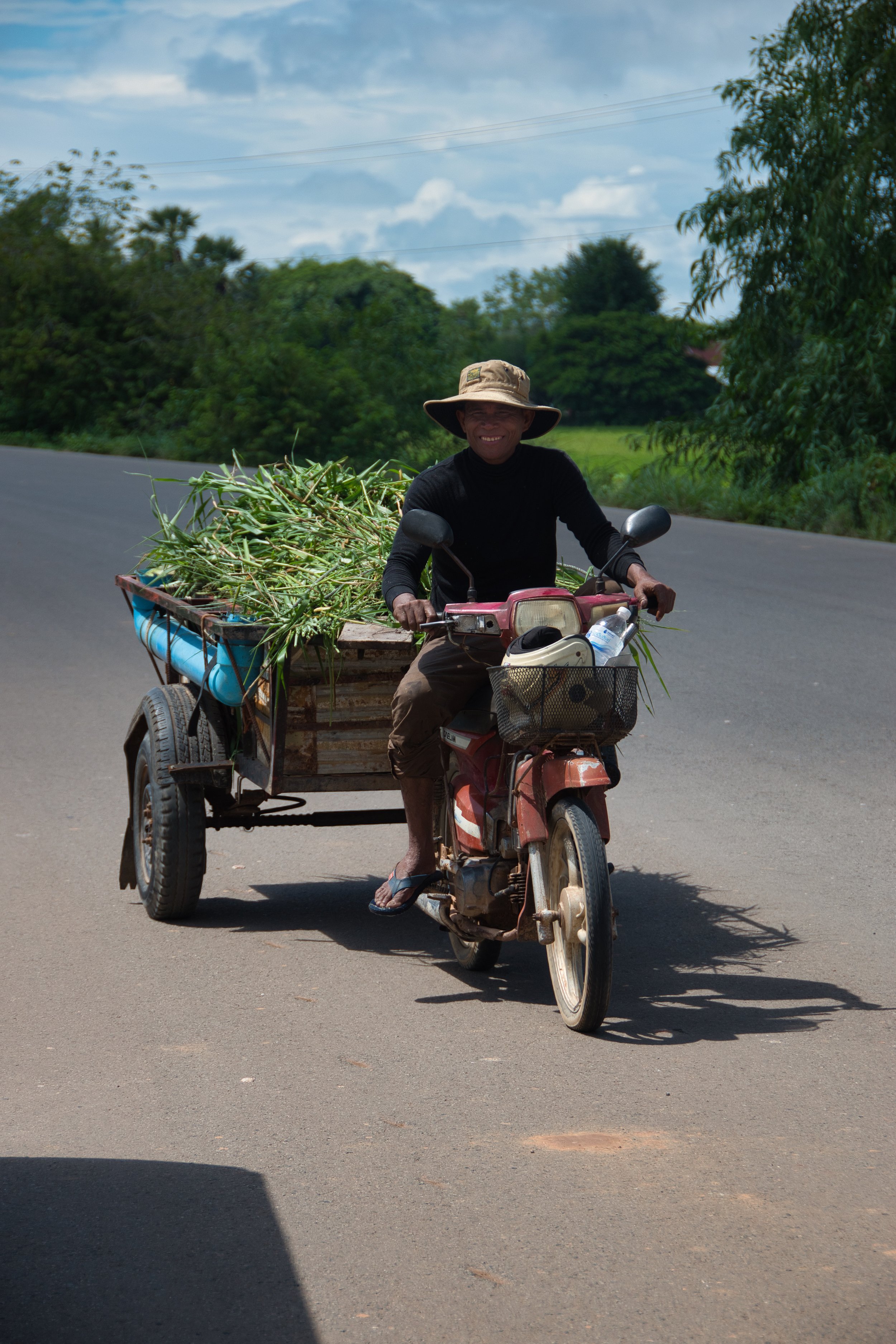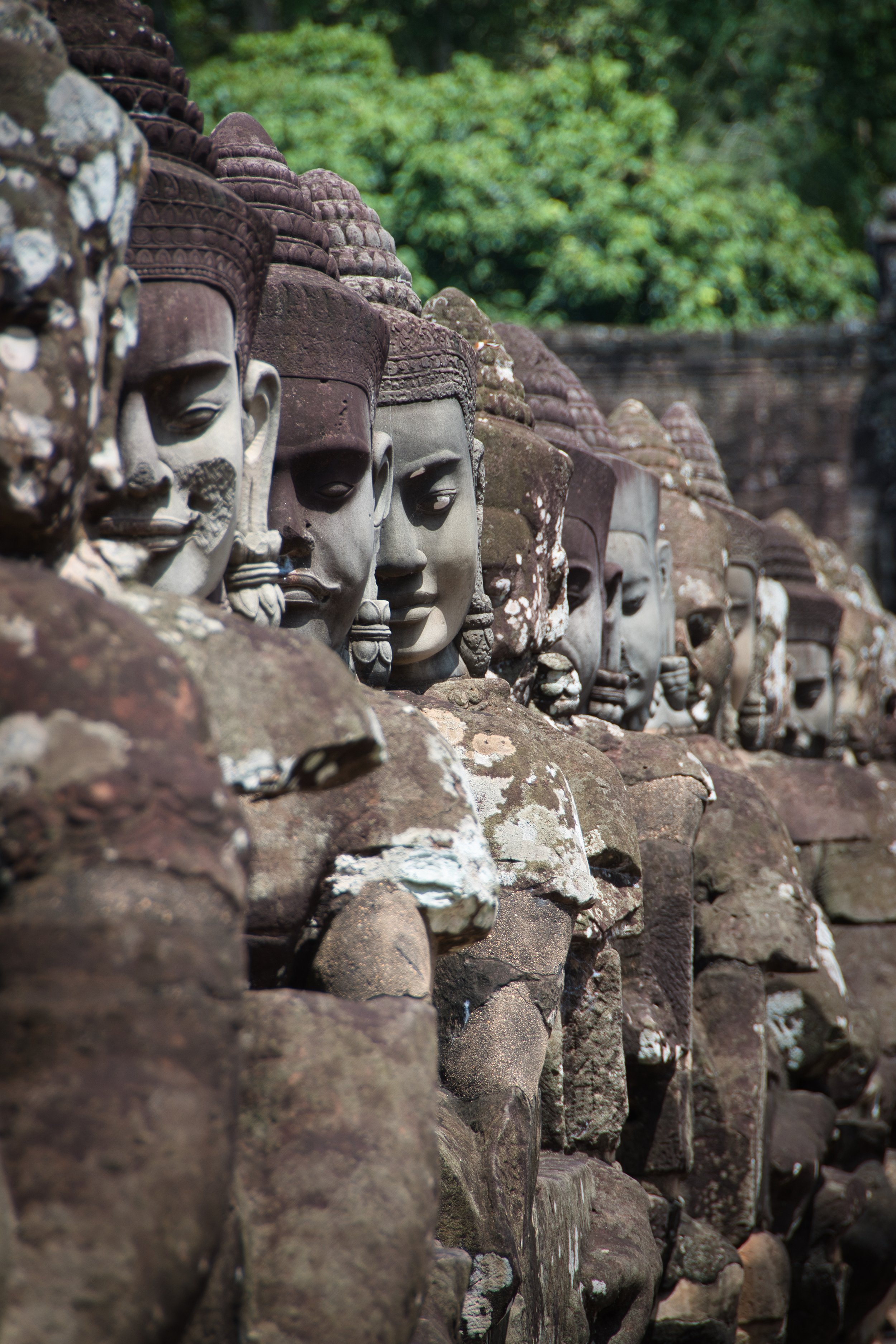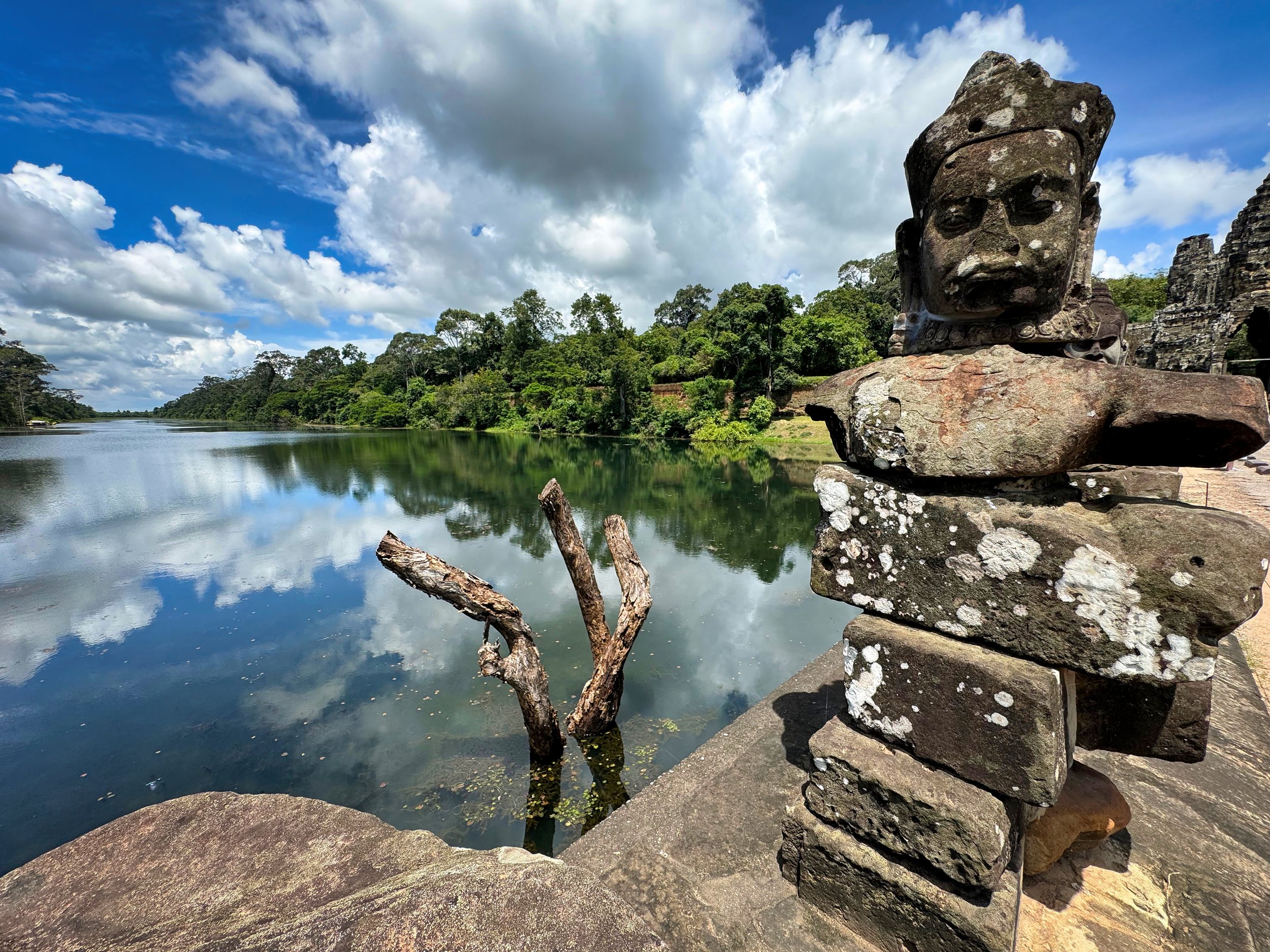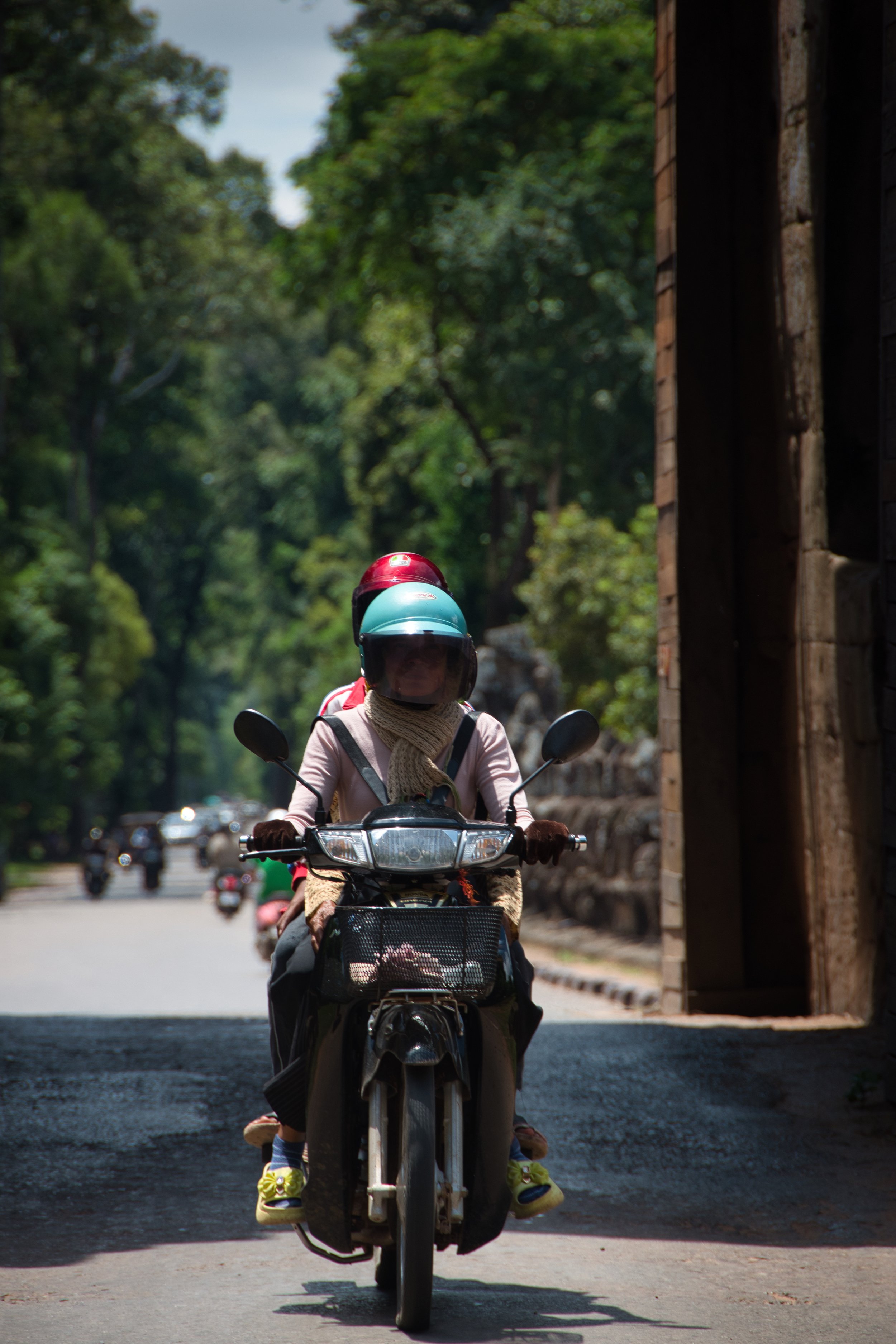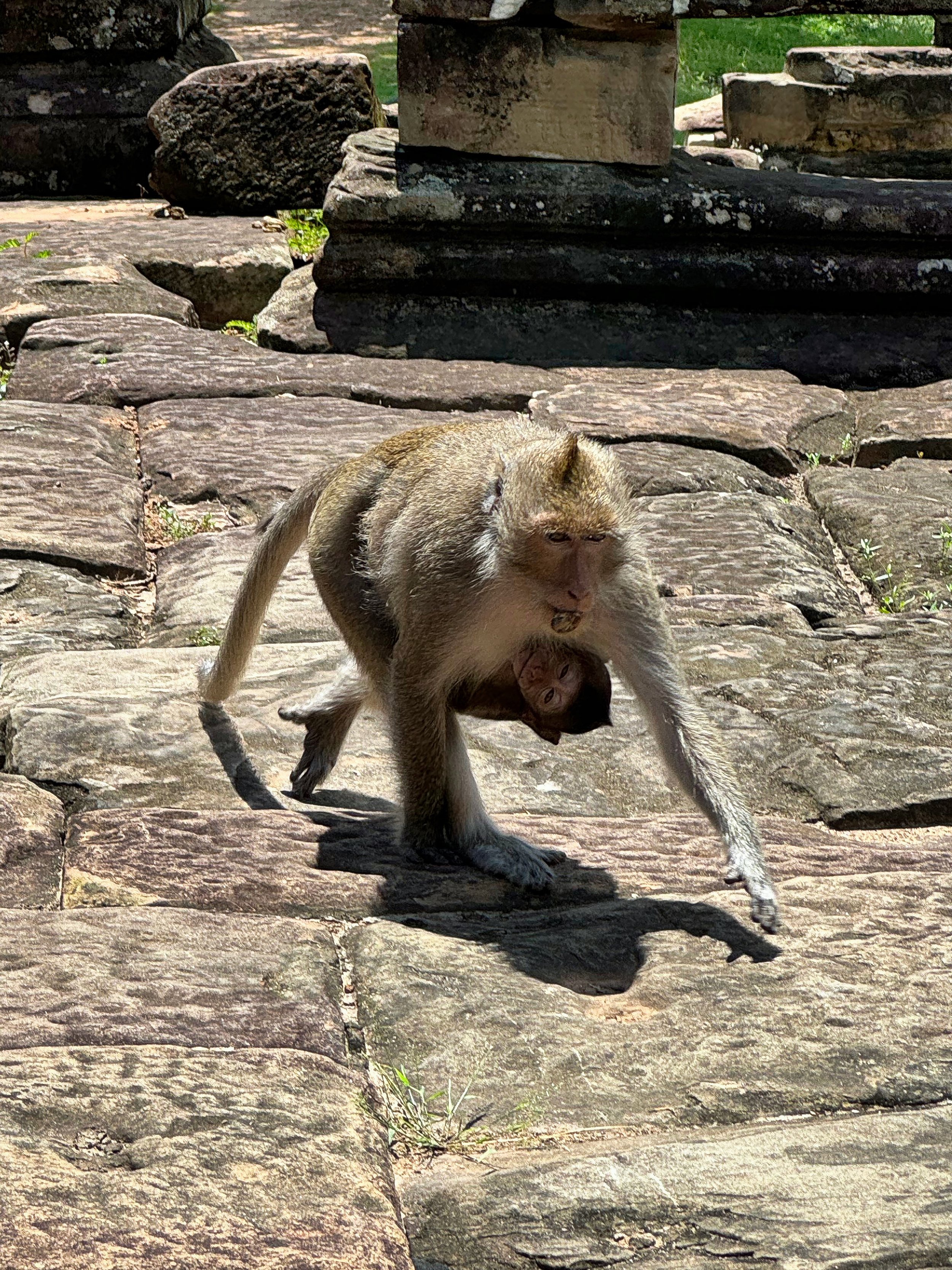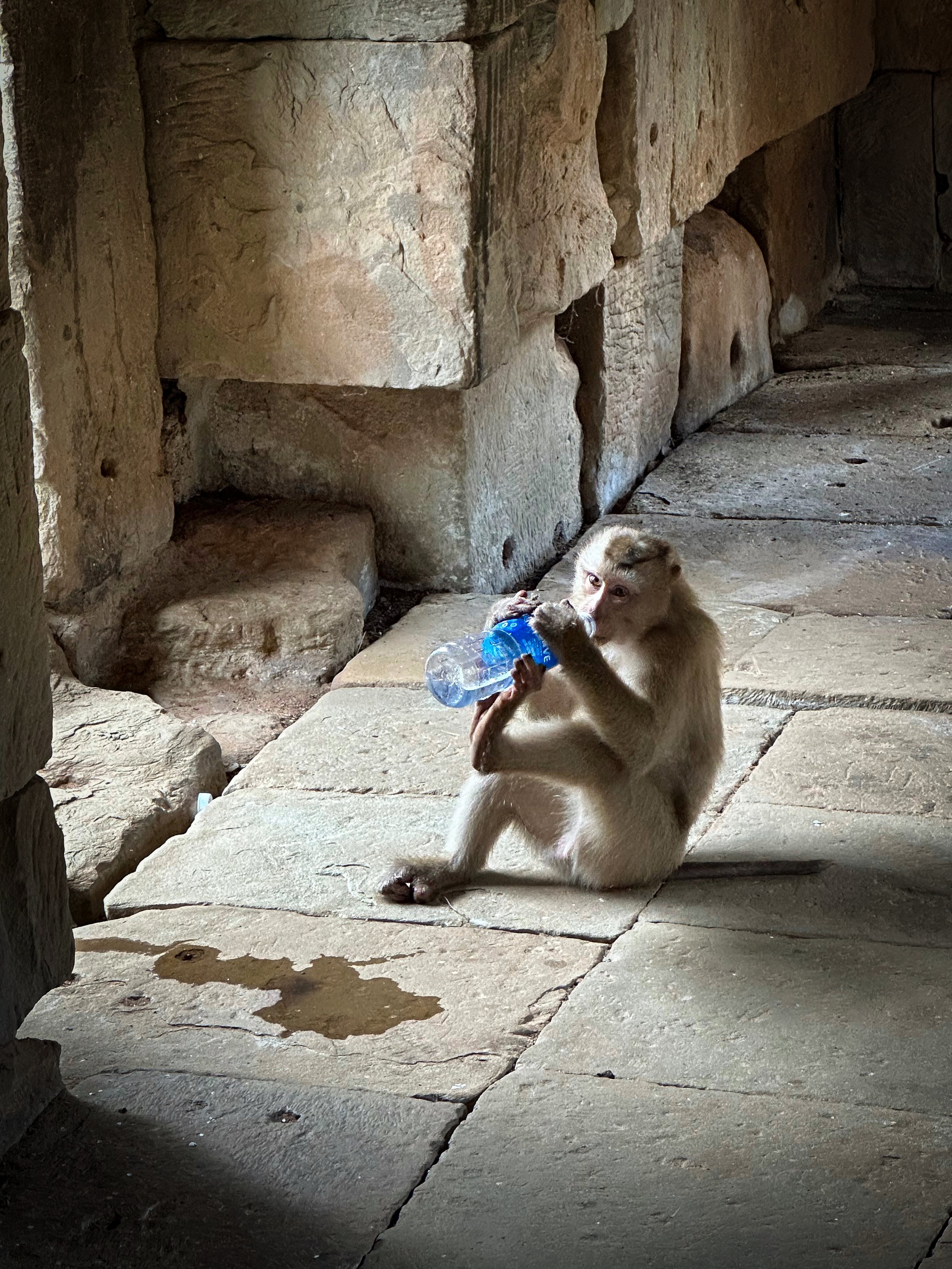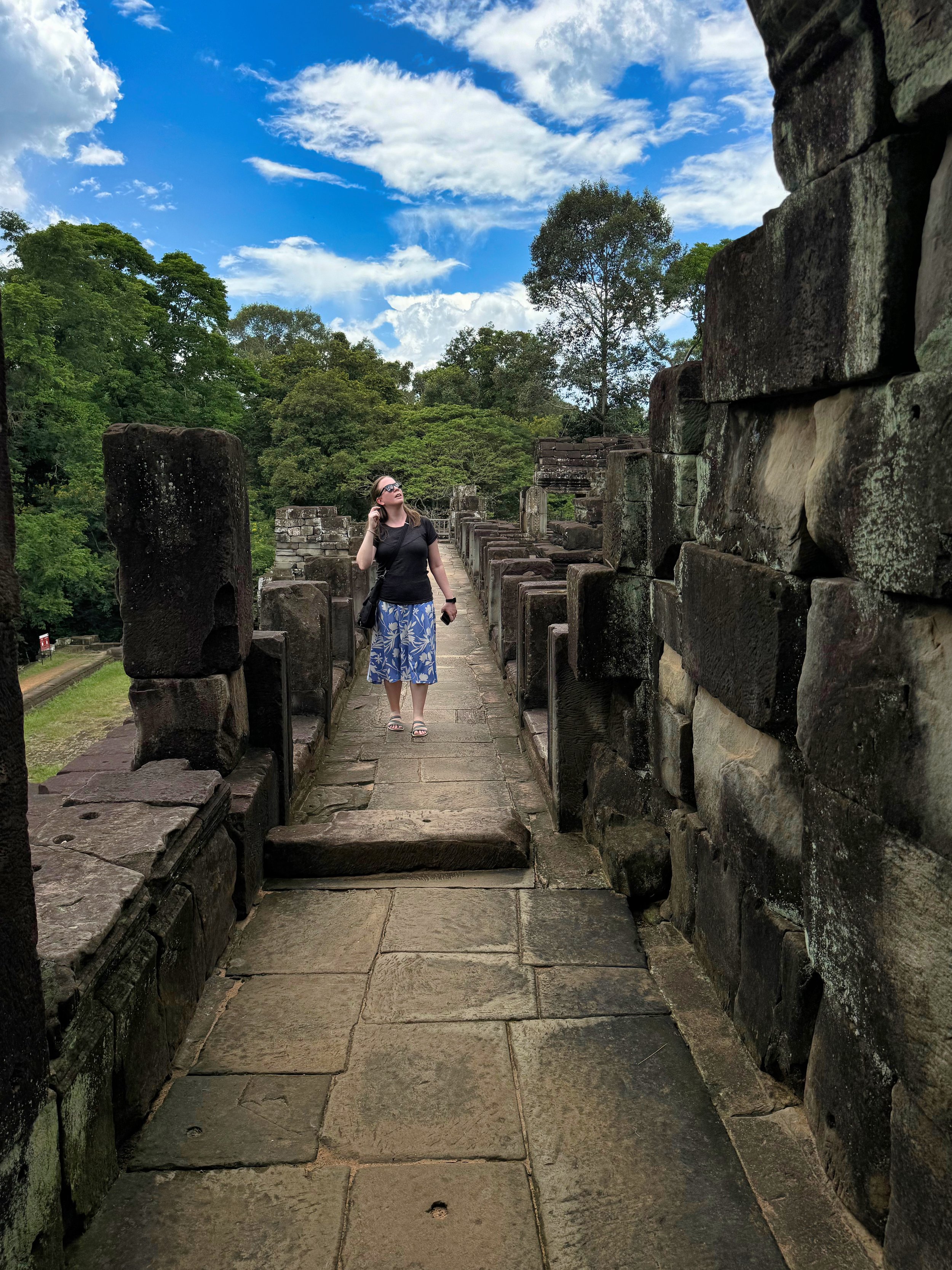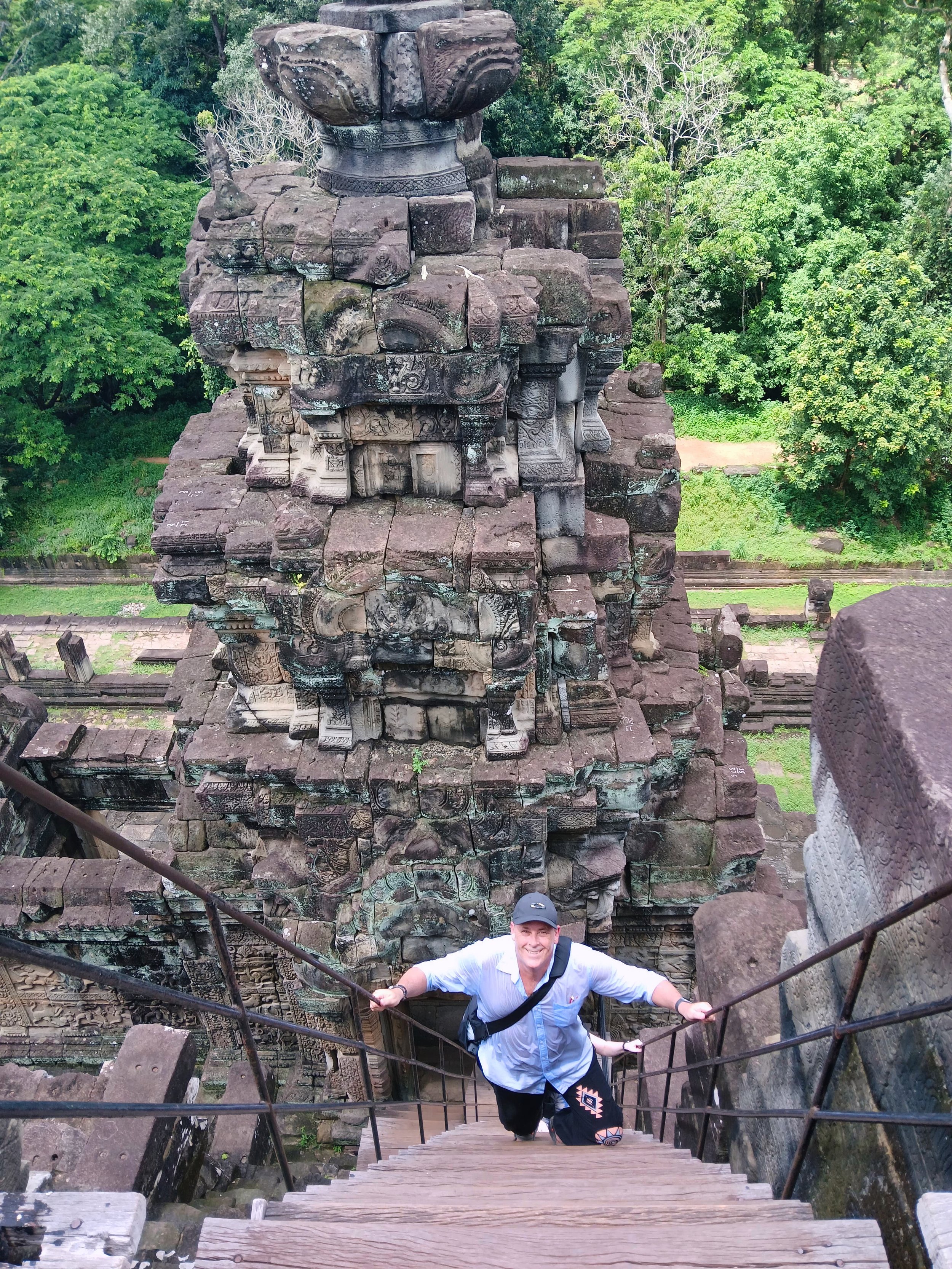Day 6 - Tonlé Sap & Angkor Thom
After breakfast Fatpap took a little stroll through the hotel grounds which honestly were lovely and akin to those found in a hotel carrying a moniker like Hilton or Park Royal. The Sonalong Boutique Resort was exactly the type of accomodation this writer seeks when away. Clean, comfortable and modern without a hint of pretentiousness or crippling price tag. The palm lined pathways scattered with statues was the perfect venue to walk off breakfast, or a hangover, and was a pleasant way to start the day. Apparently there was another temple we hadn’t yet explored but before we did Toneth mixed up the itinerary a little and had our morning filled with a cruise on the nearby Tonlé Sap Lake and the floating villages of Chhong Kneas.
Chhong Kneas floating village, Tonle Sap, Cambodia
Tonlé Sap is a freshwater lake belonging to the Mekong River system and the largest in Southeast Asia with one of the most diverse and productive ecosystems in the world. Only a short drive from town we arrived early morning to board our own boat typical of the region and idealistically picturesque. As one of the richest inland fishing grounds in the world Tonlé Sap is home to over 200 different species of fish and one million people, the majority of which actually live on houseboats creating pockets of floating villages throughout the 1,042 sq mile lake. People that is, not the fish.
On the poop deck we filled the chairs as the old boat chugged its way down the Siam Reap River en route to the lake proper. As we did, life passed us by either on long-tail boats hauling goods to sell or stationary houseboats working their way through their daily routines. It was remarkably peaceful providing little wonder why these people choose to live that way.
At the river mouth we entered an absolutely enormous waterway looking more like an ocean than an inland lake and followed a course of bouys defining fishing nets before quickly turning back into another estuary of the river. It was short lived but pretty spectacular to see the Great Lake that runs over 250km in length known as the heart of Cambodia. On the return we pulled into a floating shop of sorts which was sadly barren and remarkably spartan for the tourist trap that was apparent the moment we alighted our boat. It did however have an observation deck on its roof providing sweeping vistas of the lake and the small collection of houseboats nestled in half-submerged mangroves and flooded shrub lands.
Tonlé Sap, Siem Reap, Cambodia
Sadly thought this experience was becoming a rare negative of the Intrepid tour and one of those occasions this blogger gets to be a sanctimonious twat and sprout upon the reader the virtueless aspects of the excursion. It had been read that the residents of the floating village of Chong Khneas struggle to survive yet boatloads of tourists pass by each day to snap photos and gawk at their homes. Since the tour operations are privately owned the locals have no say or control over who comes and goes and don’t financially benefit from it. As a tourist, you are essentially paying some outside company to go look and take pictures of impoverished people’s homes, families, and their lives. In other words, the local people are exploited to generate income for a private company that has no interest or concern in the community whatsoever.
Further more, interaction with the locals was non existent. When you’re told a tour includes visiting a floating market one thinks of those near Bangkok where you can sample local dishes from the region as well as interact with the local people. In truth this was nothing like that and one of those experiences that disappointedly didn’t deliver per the brochure promises.
Having said that the trip wasn’t all doom and gloom. After making earlier comments about “photo inceptions”, basically a photo of a photo, we as a group tried on numerous occasions to capture one. Today our planets aligned and we pulled off the rarely seen, and extremely dangerous quadruple inception. Image one is the photo Fatpap took, the second is Maddy taking a photo of him, the third is Chris taking a photo of Maddy and finally, someone else taking a photo of Chris taking a photo of Maddy taking a photo of Fatpap taking a photo. It was truly masterful and poetic in nature showing just how rare the event is with the 4th photographer remaining anonymous yet having the wherewithal to capture the moment playing out before their eyes.
We returned to the dock and were immediately thrust upon with gaudy ceramic plates bearing our likeness. These photographs were snapped without warning when first boarding the boat and more often than not out of focus captures with our heads turned sideways or even looking down. Needless to say no-one purchased their unique piece of ceramic artwork despite their collectibility and investment potential.
Tonlé Sap is also renowned for its many villages dotting its massive coastline built on stilts to avoid regular rising floodwaters. On the drive back it was Fatpap who signalled a request to stop to take some photos of these structures. That turned out to be a blessing because what followed were some off the most vibrantly coloured images all tour with their mix of heavenly blue, vivid greenery and deep, deep ochres of the red clay earth. Here we did interact with the locals with many welcoming us openly to their little slice of the world and the children warmly taking photographs then laughing with us at the results. Originally not part of the morning plans, the additional 30 minutes was perhaps better than the boat ride itself?
With the photographic juices flowing, Fatpap once again sung out to the driver for another stop and despite groans from those less inclined, he quickly hightailed it down the road for an impromptu photo shoot. With an often missed chunk of rural Cambodian scenery available to him, some elusive bangers were captured adding to the collection.
Pushing on we arrived at the Angkor Thom complex adjacent to yesterdays sojourn. Meaning "Great City", Angkor Thom is the last and most enduring capital city of the Khmer Empire. It was established in the late 12th century by King Jayavarman VII and covers an area of 9 sq km housing several monuments from earlier eras as well as those established by Jayavarman and his successors.
Mythic statues representing the Churning of the Sea of Milk
Flanked by a squared perimeter wall, each side measuring an impressive 3 kilometres and encircled by a defensive moat, it was through the western gate that we entered the complex over the renowned Bridge of Statues representing the Hindu myth of the Churning of the Sea of Milk. Colossal as it was, and so very different to other monuments thus visited, the collection of stone heads were in various states of decay with some even faithfully replicated to maintain the grandeur of design.
At the centre of the city is Jayavarman's state temple, the Bayon, built in the late 12th century with its most distinctive feature being the multitude of serene and smiling stone faces of Brahma on every side of the many towers that jut out from the upper terrace. We entered through the southern entrance and were immediately besieged by a pack of roaming long-tailed macaque monkeys just going about their daily business.
The Bayon was the last state temple to be built at Angkor and the only Angkorian state temple built primarily to worship Buddhist deities. The similarity of the 216 gigantic faces on the temple's towers and other statues has led many scholars to the conclusion that the faces are representations of Jayavarman VII himself. Not at all seeing that similarity, we moved around to the eastern side of the temple entering the outer gallery opening into a grand courtyard of perfectly aligned stones and soldier-like pillars once supporting roofs of wood and tile.
The temple itself has no outer walls or moat as they were replaced by those of the outlining city proper and because the temple sits at the exact centre of Angkor Thom, all roads lead to it directly from gates at each of the cardinal points. Within the temple there are two galleried enclosures and an upper terrace with vantage points of the stone faces adorning the many towers. All of these elements are crowded against each other with little space between, and unlike Angkor Wat which impresses with the grand scale of its architecture and open spaces, the Bayon gives the illusion of being compressed within its frame.
The Bayon Eastern Pavilion
The central tower was originally cruciform but later filled out and made circular. It rises 43 metres above the ground and at the time of its foundation the principal religious image was a 3.6 mtr statue of the Buddha located in the sanctuary at its heart. During the reign of Hindu restorationist monarch Jayavarman VIII, the figure was removed and smashed to pieces only to be recovered in 1933 from the bottom of a well. It was pieced back together and now displayed elsewhere.
We departed through the north gate with only a short walk to our last temple of the day, and in fact the entire trip, The Baphuon. Built on an artificial hill the temple was originally dedicated to Shiva but later converted to a Buddhist temple as seems to be the want of most of its contemporaries. The entry to Baphuon was via a long elevated causeway that in its day no doubt crossed a vast pond defining the entrance. That pond has since greatly reduced in volume but the stonework of the bridge remains as elegant as it did during its height of occupation.
Before crossing though we took a breather as the heat today seemed more brutal than ever and the canny amongst the group noticed an imposing staircase beyond the causeway no doubt requiring our attention.
Built in the mid 11th century The Baphuon is a three tiered temple mountain and the archetype of the Baphuon style displaying intricate carvings covering every available surface. It adjoins the southern enclosure of the royal palace and measures 120 metres squared and 34 meters tall without its tower which would have made it roughly 50 meters high. So we couldn’t delay the inevitable any longer and sucked it up for the first, shorter climb to the first level. Here the perimeter was lined with window punctuated passageways, and while admiring these Mel and Fatpap were ambushed by two cheeky long-tailed macaque monkeys. Perched out of sight from ahigh, they dropped on the shoulders of each managing to reef a water bottle from Melanie’s backpack. As if to gloat, the impertinent primate then opened the screwed lid and drank its contents in front of everyone.
Continuing on we pushed higher up the 30 metre staircase to the second level. Once upon a time a 9 by 70 meter long statue of a reclining Buddha was built on the west side that probably facilitated the demolition of the 8 meter tower for stones and thus explaining its current absence. The temple was built on land filled with sand and due to its immense size the site was unstable throughout its history and large portions had most likely collapsed by the time the Buddha was added. By the 20th century much of the temple had collapsed and restoration efforts took on an epic quality. A large scale project to dismantle the temple so its core could be re-enforced before reconstruction was abandoned when the Cambodian civil war broke out in 1970. Archaeologists were forced to leave 300,000 carefully labelled and numbered blocks organised across 10 hectares surrounding the temple however the plans identifying all the pieces were lost during the decade of conflict and the Khmer Rouge that followed.
A second project to restore the temple was launched in 1996 under the guidance of architect Pascal Royère and it took his team another 16 years to complete what had become known as the "largest 3D jigsaw puzzle in the world". In April 2011, after 51 years of work, the restoration was completed and the temple formally reopened. With only one more level to conquer we marched on knowing this would be our last, and like all the mountain temples we’d visited the climb while strenuous was most certainly worth it with views across the Archaeological Park picture perfect on the very clear day. But time was unfortunately limited so we enjoyed what we could by circling the upper level before descending the staircase opposing our climb. Coming down was just as tricky as going up, and in time we made it back around to our starting point and the rest of the group.
Completely pooped and for Fatpap, dripping in sweat, we walked the last stretch to a nearby pavilion for some much needed lunch and a few cold beers. Having the staff ignite every fan possible to move the stifling heat, we dined on the largest vegetarian spring rolls imaginable and chugged more beers than perhaps we should have. Our tour was now all but over. The Vietnam leg finished a week ago and now out of nowhere the Cambodian component was pretty much done and dusted too. We savoured those spring rolls and beers for after tonight, it would be the last time we dined together or had any organised activity planed as a group.
Cambodian Monk, Angkor Thom, Siem Reap
At the southern end of the Bayon Temple where most of the buses park, there was a small clearing filled with restaurants, shops, public toilets and oddly enough a Buddhist Temple. Made of wooden planks and extremely spartan, it was here Fatpap managed to jag what he considers his best photograph of his whole time away.
Walking back to the group from the dunnies and passing under a partly opened window of the temple, Fatpap spied a young monk retreating from view. Motioning for him to return to the opening for a photograph, he fired off a series of quick pics with the best being as displayed. The brown colour pallet is simply wonderful and with the sun almost spotlighting the window, the monks’ partially hidden face and highlighted eyes against a jet black background makes this image most definitely wall-worthy. The splash of colour coming from the towel provides the pop necessary in completing the visual pull inward. As proclaimed, it is his favourite photo and arguably the best taken all holiday.
On our return to our humble little Siem Reap oasis we spent some time poolside with a few cocktails while Chris regaled us all with his learned knowledge of the various temples we’d visited, who built them, their significant individualities and architectural style employed. He was a font of wisdom who clearly loved that aspect of the tour more than anything else experienced and it was amazing to see what he’d absorbed. Some of the ladies had a hankering for further shopping so most of us obliged with a short Tuk Tuk ride to the Made In Cambodia Markets not far away.
These are a small collective of sellers offering goods made by local craftspeople. Many of the stands donate a portion of the profits to non-governmental organizations in town and the quality of merchandise is second to none and artisan in every sense of the word. Here one pays a little more than the tourist markets but the quality of goods is superior and any purchases make a positive impact on the community.
As well and good as that was, it wore thin with some of the blokes and after spying an interesting foot-volleyball game next door, some of them drifted a few shops down where icy-cold beers were readily available without having to listen to how they were procured, so finely crafted, or how great they would look back home on our living room wall. But overall everyone had a great afternoon and we gathered one last time for dinner not far from the hotel.
Tomorrow we were leaving Cambodia and crossing the border to Thailand and the day would pretty much be spent on the bus or at border control. So tonight was our farewell dinner and Toneth organised a private pavilion at a rather swish restaurant a few doors down the road. The night, as all had been, was absolutely marvellous with loads of laughs and reminiscing about the past week or so. As was the case with Chairman Boa we all pitched in and tipped Toneth rewardingly for his service during our travels through Cambodia. He in return quite unexpectedly presented us with traditional Cambodian scarfs embroided with the national flag at one end. It was a beautiful gesture and something we all will treasure for many years.
After dinner the regular bums drew together some tables by the pool and collected the remaining grog stashes from our rooms. With the bluetooth speaker once more connected we chatted the night away ensuring no excess luggage would drag us down on our way through to Bangkok.
The Last Supper, Siam Reap, Cambodia
